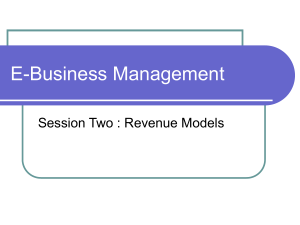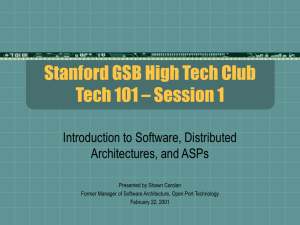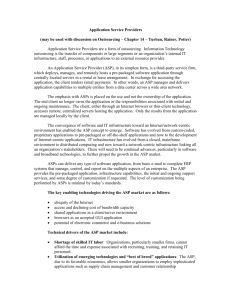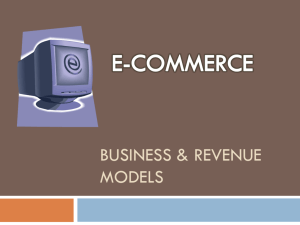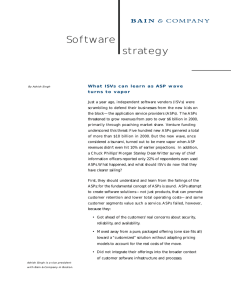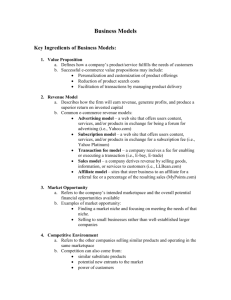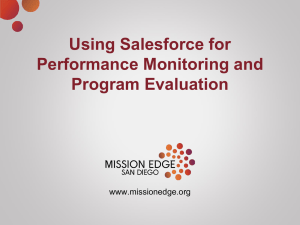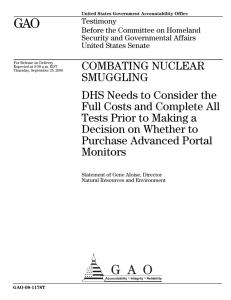Business Models 2
advertisement
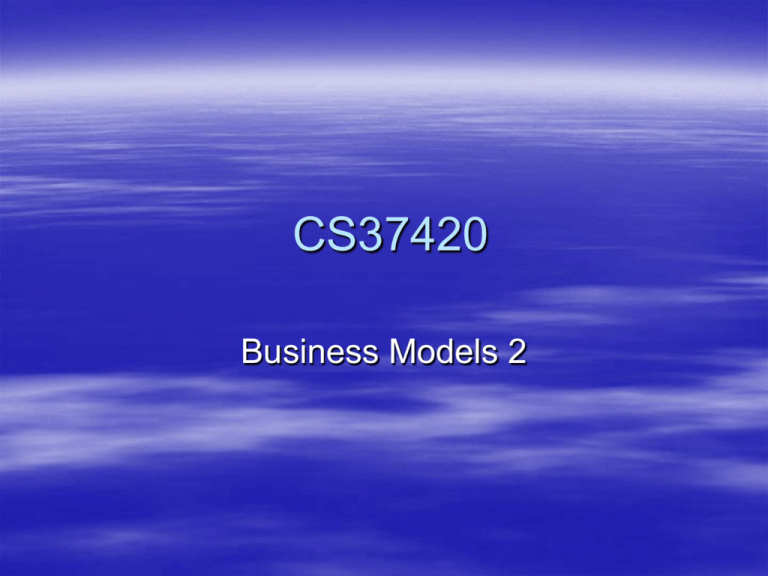
CS37420 Business Models 2 Major B2C Business Models Models where online businesses seek individual customers: Portal Content provider E-tailer Transaction broker Market creator Service Provider Community Service AOL, Yahoo, msn BBC, CNN Amazon, Dell, LandsEnd, Debenhams E-Trade, Expedia eBay xDrive (online storage) About, iVillage, Mumsnet 2 Portal Originally a gateway to the Internet, now a destination site seeks to be a user’s home base. offers an integrated package of content and services, e.g. – – – – – – – news search tools email instant messaging, shopping videostreaming music downloading etc. revenue is from advertising, subscription and transaction fees; ISPs also fall into this category and their revenue stream is subscription fees. 3 Content Provider information and entertainment providers e.g. newspapers, sports sites, stockmarket magazines, ‘how to’ guidance etc.; revenue is generated by advertising, subscription fees, referral fees and download charges; Online payment systems provide cost-effective methods for processing high volumes of small payments; key to success is owning the content; traditional owners like publishers, newspapers , broadcasters have strong advantages over newcomers; any e-commerce start up, unless it has a unique information source, will find it difficult to make money; more internet users retrieve information ( 70% ) than purchase products ( 30% ). 4 E -Tailer Many different sizes and shapes but basically a shop in all cases revenue is generated by sales of goods Examples illustrate diversity : Amazon - an online version of a retail store – a virtual merchant shopping 24/24 and 7/7 without leaving home or office; Walmart - online distribution but also physical stores (‘clicks and bricks’ or ‘clicks and mortar’); LandsEnd - online direct mail catalogue (catalogue merchant); Dell - online sales directly from manufacturer (manufacturer direct); “time starved” people are hot prospects. 5 E – Tailer highly competitive because barriers to entry are very low e.g. someone selling old fashioned sweets from home; many thousands started – and went bust! keys to success are :– keeping expenses low; – offering as broad a selection as possible; – keeping a tight control on inventory - inventory is very difficult to gauge and in fact caused eToys to fail (now relaunched); – targeting a niche to start with. 6 Transaction Broker a site offering transactions in stock dealing, travel tickets, hotel reservations, car rentals etc. and job vacancies; supplants the personal phone, fax or mail; advantages are :– – – – – faster handling wider choice reduced costs vacancies for seats and hotel – immediately rapid reaction to stock movements the largest industries using this model are :– financial services – travel services – job placement services. 7 Transaction Broker – examples online stock brokers – E-Trade , Ameritrade , Datek , Schwab – save time and money and give information and advice – revenue stream is from commissions on trades travel services – originally just airline tickets – now is general travel including hotels, car rentals, tours, packages and theatre tickets – examples are Expedia and lastminute job placement services – offer both employers and job searchers a market space for talent – revenue comes from fees for placements and increasingly for listings – examples are Monster +Hotjobs and jobs.ac.uk. 8 Market Creator Creates a digital environment where: buyers and sellers meet display products search for products establish a price for products they meet, agree price and transact revenue for the creator is a fee from each sale in addition to a listing fee example eBay; eBay has been profitable almost from the beginning – because it has no production or inventory costs. 9 Market Creator ..cont potential opportunity is very big items being traded are now moving into different areas eBay started with simple items like VCRs and DVDs now automobiles have become the largest single sector 10 Service Providers offer services online trade knowledge , expertise and effort for revenue revenue from - subscription fees , one time payments , commissions and advertising their service is – valuable , low cost , convenient and above all time – saving very valuable to busy people who are ‘time starved’ large variety of services – online information storage e.g. £ per month per Gbyte financial transaction brokers e.g. pension planning travel brokers - holiday planning grocery shopping services - Tesco 11 Community Providers sites which create a digital online environment where people with similar interests can communicate , transact and receive information of interest revenue is a hybrid model which includes subscription fees sales , transaction fees , referral fees and advertising fees from firms attracted by a very focussed audience 12 Community Providers Examples About (owned by Primedia) – offers a site with practical tips and guides to a vast array of activities – e.g. About recommends a book from Amazon and receives a fee if the book is bought Mumsnet – offers advice and tips on bring up a family etc. – gets advertising revenue from banner ads. Perhaps advertorial 13 Major B2B Business models Businesses sell to other businesses size of the market is some 4 times that of B2C value is currently estimated at over $10 trillion by 2006 it was estimated to be worth $5 trillion in 2006 it was about 1/3 of total inter-firm processing. Models: Market place / exchange (B2B hub) E – distributor B2B Service provider (ASP) Matchmaker Infomediary. 14 Market place / Exchange / B2B hub vertical – brings buyers and sellers together to reduce procurement costs for a specific industry; horizontal – as vertical but products and services across industries; revenue is from transaction fees; DirectAg (vertical) serves the agricultural market and provides farmers etc with catalogues and news of commodities; TradeOut (horizontal) helps companies with excess inventory and idle assets to sell these to other companies; Covesint (vertical) the largest in the motor industry, formed in 2000 (by the big motor manufacturers) has had a chequered existence and was bought by Compuware. 15 E-Distributor Supplies products and services directly to other businesses revenue is from sales of goods and services example - Grainger , the largest distributor of MRO (maintenance, repair and operations supplies) it added an online facility in 1995 which has become very popular 16 Matchmaker Links businesses and takes a fee for any business which occurs. similar to the B2C transaction broker; revenue is from transaction or usage fee. Example iShip was bought by UPS in 2001; now finds the cheapest shipper for business packages; lets companies compare rates and conditions from major carriers like Federal Express, Airborne, US postal services etc. then charges a fee to proceed with the shipment; its sophisticated software lets a company track its packages throughout their journey. 17 Infomediary Gathers information about consumers and sells it to other businesses revenue is from sales of information a new breed of company acting as custodians, agents and brokers of customer information while protecting their privacy. Examples: Doubleclick (audience broker) develops tools that advertisers , direct marketeers and web publishers use to plan, execute and analyse marketing programmes; Autobutel (lead generator) operates a network of car dealers to whom web users are referred in return for a fee 18 ASP: Application Service Provider the second coming of the model ? an outdated concept ? the future of software ? has public opinion changed ? software companies do they service or do they sell ? are investors interested ? 19 What is an ASP ? a behind-the-scenes business model; simply a way of selling and distributing software & software services; also called: – “software as a service “ – “on-demand computing “ – “utility computing “ drastically lowers the cost of software and services; very economical for small businesses and start-ups; ASPs in different forms have been in use for centuries. 20 Internet ASPs – common features an ASP supplies software applications and/or related services over the Internet; owns and operates a software application; owns and operates the servers that run the application; employs the people needed; makes the application available everywhere; charges for the application on either by use or on the basis of a monthly or annual fee. 21 Internet ASPs Two generations of Internet ASPs the first generation was roughly from 1997 to 2001; it rode the dot.com boom but most of them went bust in the crash; they often did not own the software which they sold as a service; they had to employ expensive experts to support their packages; the software was usually adapted from older packages; to attract clients, marketing costs became exorbitant; the few which survived evolved a different business model. 22 Second Generation Internet ASPs the second generation was from 2001 to now; second generation ASPs develop a product from scratch to be delivered as a service; match the functionality of traditional client-server applications; build up customer bases steadily; enhance their financial stability; the subscription-based model is more customer friendly; now there is a core of proven ASPs with mature products, good service and very competitive pricing. 23 Advantages of using ASPs low cost of entry; extremely short set-up time; pay-as-you-go model significantly less expensive for all but the most frequent users of the package; eliminates headcount – IT staff are usually specialised and very expensive; avoids not only the need for the user to support the application but also the need to support the specialised IT infrastructure (e.g. Oracle) required for the application; enables companies to use complex software that they normally couldn’t afford. 24 Traditional software companies and ASPs many traditional software vendors have dipped their toes in the ASP pool; companies like Oracle , Peoplesoft , SAP and Siebel have all tested the waters with varying success there is a renewed focus on an ASP strategy initially they have simply hosted legacy applications and made them available on line now they have to develop an application from ground up. 25 ASP - Salesforce.com invested in and built an expensive but comprehensive sales force management system; offers a ‘best of breed’ system which is updated regularly; it spreads the cost over many users – to date it has signed up some 82,000 companies with some 2,150,000 subscribers; Salesforce’s target is the sales management sector of a company; its software enables the sales people, wherever they are, to access and manage all their information on clients’ accounts and market through a simple web page 26 ASP Salesforce.com (cont ) all the computing is done on Salesforce’s machines; firms rent the Salesforce software for $65 per user per month; however, Salesforce only made its first profit in 2003; in 2003 it had profits of $3.5 million on sales of $96 million In 2012 it had profits of $11.5 million on sales of $2200 million (recession) expenditure on research and development, and marketing caused the earlier losses; its IPO (June 2004) raised US$110 million; although still small, Salesforce has caused an upheaval in the CRM industry 27
